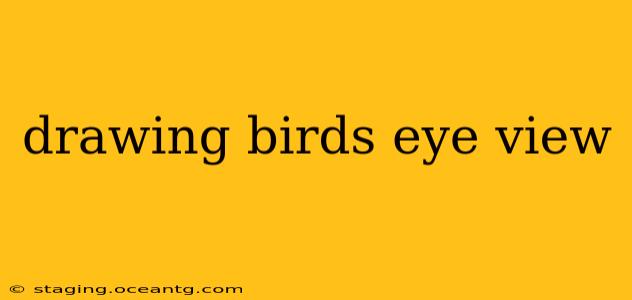Drawing a bird's-eye view, also known as an aerial perspective, requires understanding perspective, scale, and the unique visual characteristics of looking down on a scene. This comprehensive guide will equip you with the skills to create compelling bird's-eye view drawings, whether you're sketching a bustling city street or a tranquil countryside landscape.
What is a Bird's-Eye View Drawing?
A bird's-eye view drawing depicts a scene from a high vantage point, as if you were a bird looking down. This perspective offers a unique overview, emphasizing spatial relationships and the overall layout of the subject matter. It's frequently used in:
- Architectural drawings: Showing the layout of buildings and their surroundings.
- Landscape design: Planning gardens, parks, and other outdoor spaces.
- Game design: Creating maps and environments for video games.
- Illustration: Depicting scenes from an elevated perspective for dramatic effect.
How to Draw a Bird's-Eye View: Step-by-Step Guide
While the specific approach varies depending on the subject, these steps provide a solid foundation:
-
Choose your subject: What will you be drawing from above? Start with something simple, like a table with objects on it, before tackling more complex scenes.
-
Establish a horizon line: Even in a bird's-eye view, a horizon line exists, although it's typically far away and may not be explicitly drawn. Consider where it would be in relation to your subject.
-
Determine your viewpoint: How high above your subject are you? This drastically affects the perspective. A very high viewpoint will minimize the size of objects and emphasize their spatial arrangement. A lower viewpoint will show more detail and retain a sense of scale.
-
Lightly sketch the basic shapes: Begin with simple geometric shapes to represent the main elements of your subject. Focus on their positions relative to each other.
-
Add details: Gradually refine your sketch by adding details to the objects. Pay attention to proportions and ensure everything is consistent with your chosen viewpoint.
-
Consider perspective: While objects further away appear smaller, in a bird's-eye view, this effect might be subtle depending on the height of your viewpoint. Focus on the convergence of lines to create depth, even from above.
-
Refine and shade: Once you are happy with the shapes and details, refine your lines and add shading to create depth and dimension. Shading from above will create a different effect than shading from a side perspective.
What are the Key Elements of a Good Bird's-Eye View Drawing?
- Clarity: The drawing should be easy to understand and interpret. The spatial relationships between objects should be clear.
- Accuracy: Objects should be drawn in their correct proportions and positions relative to each other.
- Depth: Even from above, the drawing should suggest depth and three-dimensionality through shading, perspective, and the use of overlapping objects.
- Composition: Think about how you arrange the elements in your drawing to create a visually appealing and informative composition.
How to Improve My Bird's-Eye View Drawings?
- Practice: The more you practice, the better you will become at understanding and depicting aerial perspectives. Start with simple objects and gradually increase the complexity of your subjects.
- Study examples: Look at existing bird's-eye view drawings and illustrations to understand how other artists have approached this perspective.
- Use references: Use photos or real-life objects as references to ensure accuracy in your drawings.
- Experiment with different mediums: Try different drawing tools and techniques to see what works best for you.
What are some common mistakes to avoid when drawing a bird's-eye view?
- Incorrect proportions: Ensure all elements maintain accurate scale relative to each other.
- Lack of depth: Utilize shading and overlapping objects to suggest three-dimensionality.
- Ignoring perspective: Even from above, perspective lines (though subtle) exist and contribute to depth.
- Inconsistent viewpoint: Maintain a consistent vantage point throughout your drawing.
By following these tips and practicing regularly, you'll soon be creating impressive bird's-eye view drawings that capture the essence of looking down on the world. Remember, practice is key! The more you draw, the more comfortable and skilled you'll become at creating these unique and effective perspectives.
